DAVID TORNEZ LUVIO and HÉCTOR MARIO BENUMEA, Pemex and LUIS EUGENIO DÁVILA DE GÁRATE, EDHER RAMIREZ LOAEZA, IVÁN PÉREZ and NEIL SOOKRAM, Schlumberger
When the water cut in one of its best-producing wells doubled in six months, operator Pemex (Petroleos Mexicanos) needed answers fast. The asset team was eager to figure out where the water was coming from, then develop and apply an appropriate water-conformance solution. However, there were several challenges to getting an accurate, reliable production log in an operating, horizontal well with multi-phase production flow. But without an accurate production profile, applying a water-conformance treatment was riddled with uncertainty.
Pemex partnered with Schlumberger, to do a thorough study of the problem, which included using the service company's fiber optics-enabled, integrated coiled tubing (CT) production service to deploy its multiphase horizontal and deviated well production logging system, to get the required flow profile of the well’s entire producing zone. The study results and log data analysis helped Pemex make the right decision, to avoid serious production losses in the field's most prolific well.
FIELD AND WELL BACKGROUND
Located in southern Mexico, the well was one of the first horizontal completions in the field, and had been online and flowing naturally for more than four years. The sandstone reservoir has strong aquifer support, so the water-drive production mechanism that helped the oil output was dropping slowly. However, complex, multiphase downhole flow is common in the field.
The well was drilled as a multi-lateral completion, to contact different reservoir layers. One lateral has a directional type “J” leg profile, with an objective of producing a lower sandstone layer, and the second horizontal section cuts an upper sandstone layer.
The horizontal section features an expandable sand screen, installed as a liner, in the production zone. Of the more than 1,000 wells in this region, only three or four have this type of completion, so locally it is considered "unconventional." This well section had not been explored in the four years, since the screen was installed. This lack of information led to uncertainty of the well profile; obstructions might have developed inside the screen that could require cleaning out before running a production log, thereby complicating the intervention.
PROBLEMS BEGIN
After about four years, of consistent production, the water cut jumped from 20% to almost 40%, in just six months, Fig. 1. Even though Pemex has the surface facilities to manage water, the extra hydrostatic pressure began to hamper production. It was predicted the well would not sustain this rapid water cut increase.
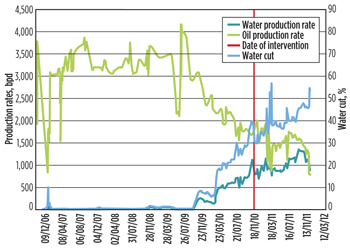 |
| Fig. 1. History of production. |
To identify water-producing zones, in the horizontal and lateral legs, the operator knew that they needed to run a production log. However, they were concerned about shutting in their best-producing well, even for the few hours it would take to run the log, because associated deferred production with the intervention was objectionable. Furthermore, they knew conventional wireline logging tools would present challenges from both operation and interpretation. Then, assuming they could even get the production logging tool (PLT) string to the end of the horizontal section, to actually complete the log, it would be difficult to get a complete, accurate analysis to define a proper water conformance treatment.
SOLUTION OVERVIEW
Pemex partnered with Schlumberger for a thorough study of the well. This included using a fiber optics-enabled CT production service to deploy its horizontal and deviated well production logging system to get a flow profile of the entire producing zone of the well’s screened horizontal section. This confirmed where, and how much, the lateral “J” leg was producing.
The work began with a team, composed of engineers from both the operator and service company, studying the well characteristics, to properly identify the cause of water production, with a goal of providing a complete solution. This engineered approach was first focused to identify whether the produced water was related to the aquifer support mechanism, which usually means water is required to produce oil or whether it was another water phenomenon that hampers production. Therefore, as a first approach, the study team analyzed the production history data from the well with a diagnostic plot, Fig. 2.
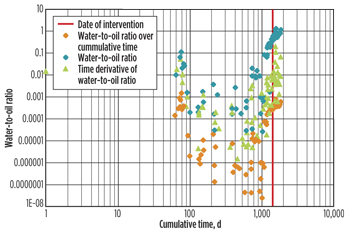 |
| Fig. 2. WOR diagnostic plot. |
The diagnostic plot clearly showed when the water–to-oil ratio started to build up, and thus, identified the breakthrough. At about 1,000 days of output, the well started to show its first signs of water production. Then, the characteristics of the field were taken into account for the interpretation of the plot and for the recommendation to run a production log to correctly identify the water irruption in the wellbore. The data hinted at an early trend of edge-water flow, because it showed a rapid increase trending to a straight-line curve, signs of “good” water production necessary to maximize oil recovery in this well.
TECHNOLOGY
The integrated CT production service uses fiber-optic telemetry and downhole wireline data conversion to run real-time tools (such as the production logging tool) that are typically conveyed on conventional wireline, Fig. 3. This allows for high-quality onsite evaluation, well stimulation treatment, and real-time diagnostics in just one trip to the wellsite.
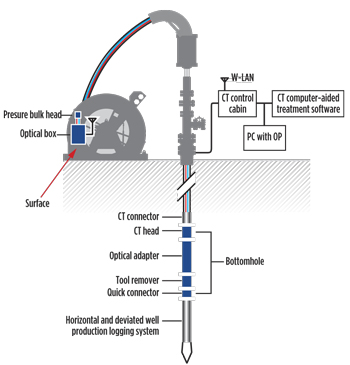 |
| Fig. 3. The integrated CT production service for production logging, with the PLT. |
The design of this horizontal and deviated well production logging systems has been optimized for three-phase logging in highly deviated or horizontal wells, Fig. 4. Electrical probes distinguish water and hydrocarbon holdup, and optical probes differentiate gas and liquid holdup, to fully measure three phases. Additionally, the tool measures phase velocity for calculating multiphase velocity profiles. A maneuverable arm deploys the multiple sensors (five mini-spinners and 12 phase-probes) along the vertical axis of a horizontal well, setting those sensors in maximum contact with each phase, Fig. 5.
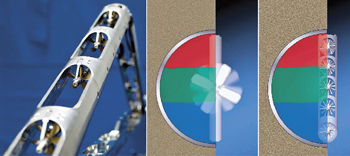 |
| Fig. 4. The horizontal and deviated well production logging tool, showing the advantage of the multiple-sensor vertical array in a horizontal well. |
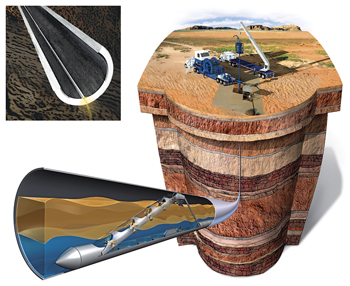 |
| Fig. 5. The integrated CT production system with inset showing encased optical fibers inside the CT, and the deployed horizontal and deviated well production logging tool. |
The fiber optics-enabled, integrated CT production system permits pumping through the CT at nominal rates, and the equipment on location was ready, in case any restrictions were encountered, or in case the well needed to be cleaned out for the PLT. However, even though the tool caliper showed several damaged areas inside the horizontal expandable-screen completion with reduced diameters, the tool string was successfully and safely run all the way to the bottom of the well.
OPERATIONS
The intervention operations were on an accelerated schedule. The team wanted to take advantage of scheduled surface facility maintenance that would shut in the well for four hours so the deferred production would not be allocated to the intervention. Four hours was not enough time to do a complete production logging run, but provided a window of opportunity to do a closed well logging run. Since, the service company's specialized CT deployed the PLT to the bottom of the horizontal section as the well was flowing, so the PLT flowing run was done the day before the surface maintenance shut-in.
The first step of the process was to drift the well to confirm accessibility to the horizontal section total measured depth (MD). To sensitize friction coefficients from intervention software simulations to match the measured results acquired at the well site, a calibration run was performed with the exact length and outside diameter of the logging tools.
To acquire the necessary data for a full visualization of the horizontal flow profile, the team determined that three logging passes were required in the horizontal sand screen, with different stationary logs, depending on the production allocation, identified from the previous logging passes.
During the flowing run and with the aid of real-time data being analyzed by the engineering team at the well site, a fourth logging pass was deemed necessary to compile extra data. Also, because there was no previous PLT in the horizontal section, and the program called for stationary logs, this fourth logging pass helped to recognize five different contribution zones. Next, the team had to perform stationary logs to complete the production allocation from the main producing zones. After that, the flow profile diagnosis resulted in a better understanding of complex flow mechanism across multiple producing zones, determining the multiphase flow characteristics of the well.
During the four hour shut-in, the team ran a final pass during static conditions. These results confirmed that the lateral “J” leg of the well was not contributing to the production and demonstrated that no cross-flow conditions were present.
THE RIGHT DECISION
The high-quality, real-time data obtained from the production log revealed water production throughout all hydrocarbon producing zones of the well’s horizontal section, Fig. 6. With the phases so comingled, it would be impossible to isolate the water-producing zones, and there was a high risk that the reduction in permeability created by a water-conformance treatment would decrease the well’s overall productivity.
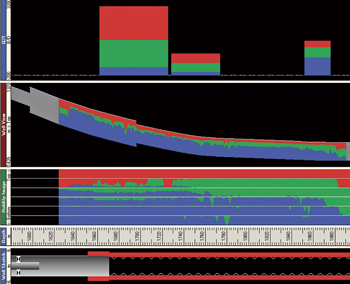 |
| Fig. 6. Holdups and flow profile interpretation from the production log revealed water production in all of the hydrocarbon producing zones. |
The asset team decided to suspend the water-conformance treatment in the short term, thereby avoiding the expense and risk of this operation. Because production facilities have sufficient capacity to handle the produced water, the well was not choked back. The aquifer is maintaining pressure and has allowed the operator to continue producing the well for more than a year with only a small increase in water cut and little additional drop in oil production. These results justify the decision to cancel the water-conformance treatment and support the initial evaluation of edge-water flow from the diagnostic plot. 
|
The author
SAM GORGENDAVID TORNEZ leads the link coordination operation of the Samaria-Lun production asset of Pemex in southern Mexico. Mr. Tornez earned his BS degree in petroleum engineering in 1985 from Instituto Politecnico Nacional IPN in Mexico City. He has been with Pemex for more than 27 years, working in the southern region of Mexico, serving in several technical and operational positions, including well analyst and interpreter of developing fields, in the area.
HÉCTOR MARIO BENUMEA is a productivity engineer from Pemex. He is an artificial lift systems specialist from Production Asset Muspac-Macuspana. Mr. Benumea is a graduate of the Instituto Politecnico Nacional IPN, Mexico City, where he earned his degree in petroleum engineering in 2006. Mr. Mario joined Pemex in 2007.
LUIS EUGENIO DÁVILA DE GÁRATE is a senior ACTive technology implementation specialist for Mexico and Central America. He is a general field engineer in the Coiled Tubing Services group, specializing in fiber optics technology and distributed temperature surveying (DTS). In 2005, Mr. Davila obtained his BS degree in industrial physics engineering from the Insituto Tecnologico y de Estudios Superiores de Monterrey (ITESM) in Monterrey, Mexico.
EDHER RAMIREZ LOAEZA is the Schlumberger Data Services Borehole Reservoir team leader for Mexico and Central America. He is a specialist in the company for formation testing and production logging interpretation, covering wireline applications of reservoir and production engineering to oil and gas fields. In 2006, Mr. Ramirez obtained his BSc degree in petroleum engineering from the Instituto Politecnico Nacional in Mexico City.
IVÁN PÉREZ is the Schlumberger Data Services, Well Integrity team leader and part of the Borehole Production for Mexico and Central America. In 2008, Perez earned his BSc degree in petroleum engineering from the Universidad Nacional Autonoma de Mexico, in Mexico City.
NEIL SOOKRAM is the Schlumberger Wireline domain champion in production and well integrity for the Mexico and Central America. In 1996, Mr. Sookram obtained a Maitrise degree in Integrated Reservoir Management from the Institut Français du Pétrole, Paris, France. He previously earned his BSc degree in electrical engineering in 1987 from the University of the West Indies, Trinidad and Tobago. He has been with Schlumberger for more than 24 years, serving in several technical and operational positions covering various countries within North and South America. |
|








